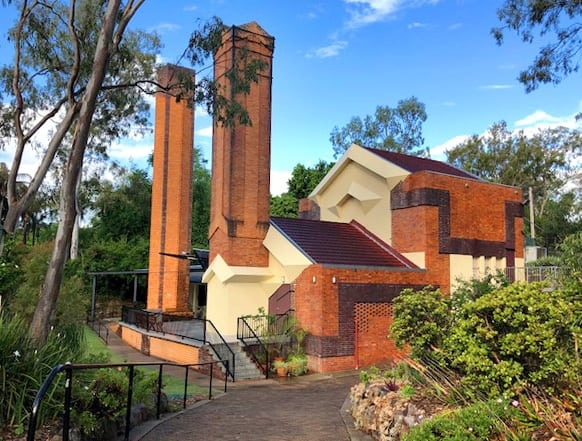Have you ever been to the Ipswich Nature Centre in Queens Park and wondered what those huge brick columns are poking out above the trees?
Well, we’re glad you asked.
It was originally the Ipswich Municipal Incinerator used to burn all of the town’s rubbish. The brick columns were its chimney stacks.
It was officially opened on in November, 1936 and despite being an industrial firebox, it had orange and mulberry bricks, fret work and art deco chevron shapes.
Maybe it was so fancy because it was designed by the same guy who designed Canberra. That’s right. Walter Burley Griffin designed Ipswich’s Incinerator. It was the only building in Queensland that he designed.
Ipswich’s own architect superstar George Brockwell Gill supervised the construction.
When the town got too big and it became unfashionable to burn rubbish, it was decommissioned.
Council resolved to demolish it. Public meetings were held and the Ipswich branch of the Arts Council was granted a short-term lease.
The building was then converted to a theatre seating about 80 people.
(above) The building was officially opened on 5 November 1936.
(below) The abondoned building in the 1960s.
In November 1969 the building was officially reopened as the Incinerator Theatre and has been home to the Ipswich Little Theatre ever since.
Conditions were extremely primitive at first. The audience sat on hired chairs on a flat floor, the holes having been filled in by the Army Reserve next door. Stage lights were made from large jam tins.
Every year a show was performed on the flue between the two chimneys.
Things have improved somewhat since then. It has been refurbished a few times and extended mostly by voluntary labour and working bees.
It runs regular shows and also hosts the longest running drama festival in Australia, the One Act Play Festival.
Ipswich Little Theatre president David Austin has all sorts of stories to share about the people who perform, work backstage or come along to see the shows.
“A couple of years ago a man and woman met each other on the stage for the first time. On the day they got married, they popped in to the theatre to see if they could get some pictures taken there, as it was where they first met,” he said.
“It was James and Christine Miles. We were all there rehearsing a new show. While we were on lunch break they jumped up on stage and we all sat on the chairs clapping while they had their pictures taken.”
Lots of people think there is a ghost there moving things all the time.
“I think people just forget where they put things. Sometimes when the lights go out it probably means you just have to change the bulb,” he laughs.
Burley Griffin Incinerator Building Committee chairperson Helan Pullar said this little building has had an interesting journey.
“It is an excellent example of adaptive re-use of an historical building and, in particular, a Burley Griffin incinerator. While there is none of the original machinery that there is in other incinerators, the conversion has had minimal impact on the original structure which makes for easy interpretation from the incinerator that was to the theatre that is.
“While the Incinerator itself is mainly used by our mainstream senior theatre, in our secondary building we run both a primary and a high school group and another for people with disabilities. Other members perform pantomime for local school children, or perform short plays and serve lunch to groups visiting our heritage site. The complex is in constant use,” she said.

